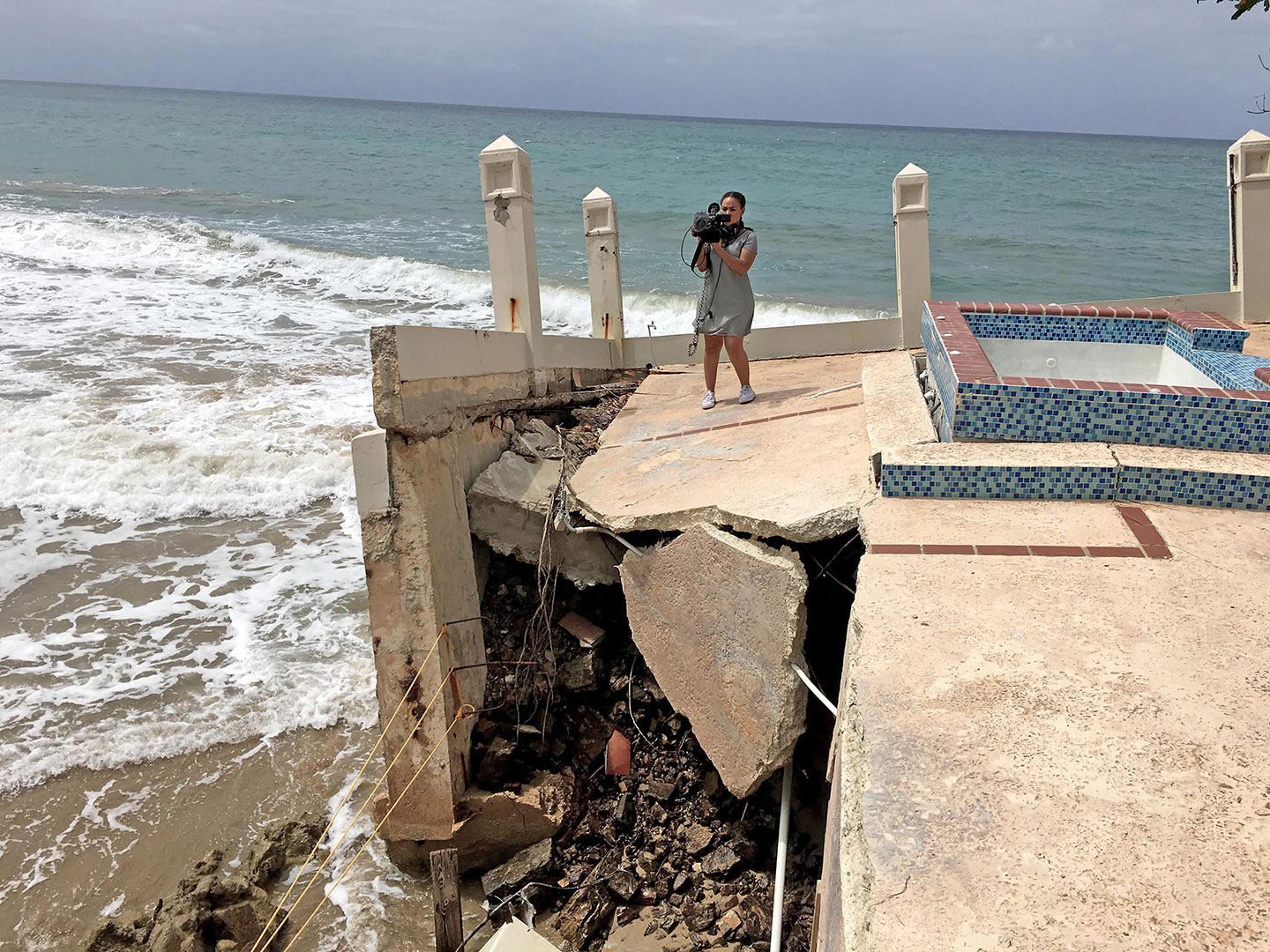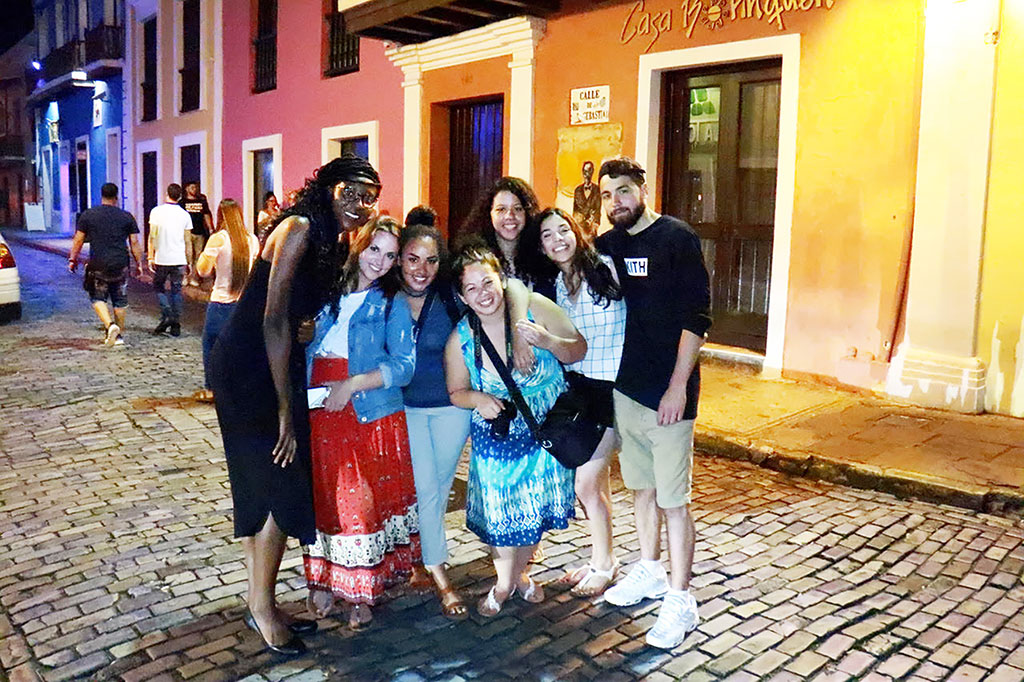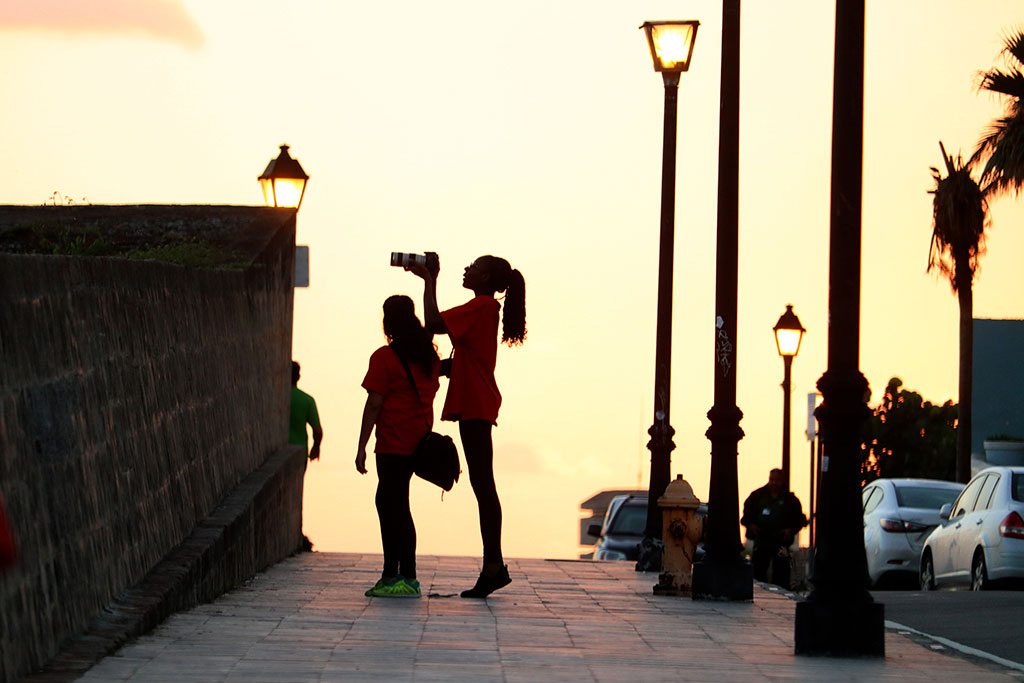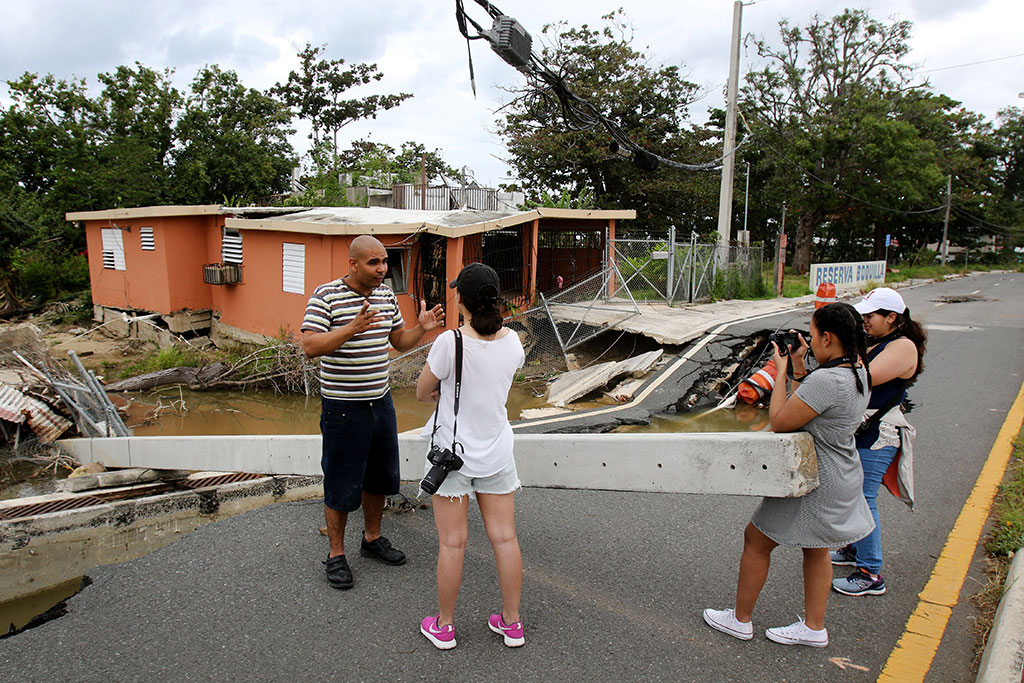
After the Storm
Students work through spring break to document stories of resilience and recovery in Puerto Rico
Photos By Thomas E. Franklin
Senior Natalie De La Rosa films storm damage on the pool deck of Tres Sirenas, an oceanfront boutique hotel in Rincón, Puerto Rico.
As Hurricane Maria barreled through Puerto Rico last September, cutting off communication to the island territory and leaving as much as $95 billion in damage to the region in its wake, Communication and Media Arts major Mariano Arocho anxiously awaited news about his grandparents, who live there. “We waited for three days,” he recalls. “My mother found a blog post online and the blogger had taken a photo of my grandmother at a shelter. We emailed the blogger and found that they were safe. It was very relieving.”
Six months later, Arocho joined a group of students, faculty and staff from the School of Communication and Media (SCM) on a weeklong spring break trip to Puerto Rico for a collaborative journalism project to cover stories of resilience and recovery in the aftermath of the storm.
For Arocho, and other students with ties to the island and the region, the experience was intensely personal. “I’m Puerto Rican,” says Arocho, a senior. “My grandparents were greatly affected when Maria hit.”
I realized you truly have to love storytelling for this job – and I can honestly say I do. This is what I want to do for the rest of my life.
Seeing the trip as an opportunity to enhance his journalism and video production skills, Arocho filmed Abuela’s Hogar – a documentary of how the storm flooded the nursing home his grandparents owned and has been a labor of love for his abuela (grandmother) for years. “They’re now planning to sell their business,” he says. “My abuela can no longer do what she loves to do. It breaks her heart, but now’s the time for her to retire.”
For some college students, spring break is often a time to relax on a beach, but for Arocho and the others on this trip, spring break was a working vacation – and an opportunity to produce meaningful work.

Hurricane Maria was the worst natural disaster in Puerto Rican recorded history, and when they arrived, Arocho and six other students, along with professors Thomas Franklin, Steve McCarthy and David Sanders, and staff members Marie Sparks and Krystal Acosta, quickly discovered that recovery is far from complete, as signs of devastation linger across the island.

A cultural and journalistic experience
The stories that the students worked on focused on how people and communities came together to face adversity and hardship in the wake of the storm.
“We wanted to provide an opportunity for our students to have a cultural experience as well as a journalistic experience in a place where a big, prolonged news event was occurring,” says Franklin. “On a scale of one to 10, this trip was a 20, especially in terms of the students’ development and growth in the short time we were there.”
Looking back on the trip, Sanders reflects that the experience for the students was both character- and career-building. “They came out of the trip with a real taste of working in the professional world. The bonus is that the media projects they produce will really stand out from their peers when they begin to look for work.”
Senior Television and Digital Media major Natalie De La Rosa also identified with the islanders’ plight. “Being an islander myself from the Dominican Republic, I felt I could help people by telling stories we don’t usually get to hear in the states,” she says. Her video features business owners who shared how they coped with hardships before, during and after the storm.

“A lot of places we visited looked as if we were back in September when Maria hit,” De La Rosa says. “I wasn’t expecting to see houses under water, cars underneath sand, and houses without roofs. The island isn’t even close to being repaired.”
While shocked by the island’s devastation, De La Rosa was impressed by people’s positive spirit. “Everyone greeted us with a smile and love in their eyes,” she recalls. “Many said they were just happy that somebody was willing to listen to them.”
Excelling at storytelling
The professors say they run their journalism and documentary trips like professional shoots.
“Before we go, each student is charged with researching and casting a story,” says McCarthy. “The daily production really reinforces what we teach – storytelling. It’s like developing a muscle. We train them to set up the gear, ask the questions, film the shots and then pack up and go to the next location.”
For senior Journalism major Madison Glassman, the trip not only gave her invaluable real-world experience, but it reminded her that journalism is all about telling and sharing stories.
She also learned that journalism is hard work. “It’s long hours, no breaks and putting personal needs aside for your work,” she says. “I realized you truly have to love storytelling for this job – and I can honestly say I do. This is what I want to do for the rest of my life.”
Glassman’s video focused on Cypress Missions, a group from Brielle, New Jersey, that was helping to repair a damaged church and rectory in Vega Baja. “I met them the day I filmed my story, but by the end of the day, I felt like we were family.” Among the volunteers were Montclair State alumni Medaly Rodriguez Jones and Jay Jones, who had met while attending the University.
Cross-cultural collaboration
According to Franklin, the team benefited from unique cultural and learning experiences gained by collaborating with University of Puerto Rico students and faculty.
“The Puerto Rican students were phenomenal,” says De La Rosa. “They were such a great help to the team – from guiding us around the island to literally being involved in some of our pieces.”
Through this collaborative process of capturing and sharing stories of Puerto Rican resilience, recovery and hope, the Montclair State team hopes to further the understanding of the lasting impact of Hurricane Maria on Puerto Rico.
Arocho recalls that while the Puerto Ricans were unwilling to let a hurricane completely disrupt their lives, they still need help to recover. “There are people still without power and still without roofs over their heads. It’s important to understand this and do what we can to help.”
To watch the students’ stories, visit wiredjersey.com/mission-to-puerto-rico